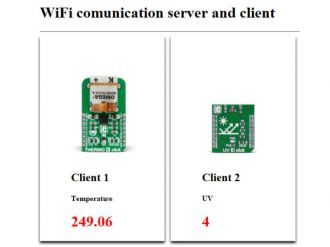
We strongly encourage users to use Package manager for sharing their code on Libstock website, because it boosts your efficiency and leaves the end user with no room for error. [more info]

Rating:
Author: MIKROE
Last Updated: 2017-08-30
Package Version: 1.0.0.0
Category: WiFi
Downloaded: 1265 times
Not followed.
License: MIT license
Embedded web server based on WiFi ESP click (ESP8266) used as smart home system.
Do you want to subscribe in order to receive notifications regarding "Smart Home System" changes.
Do you want to unsubscribe in order to stop receiving notifications regarding "Smart Home System" changes.
Do you want to report abuse regarding "Smart Home System".
| DOWNLOAD LINK | RELATED COMPILER | CONTAINS |
|---|---|---|
| 1504079810_smart_home_appli_mikroc_pic32.zip [292.25KB] | mikroC PRO for PIC32 |
|

Minimum hardware requirements
Example provided uses EasyPIC Fusion V7 board with PIC32MX795F512L as embedded web server and two clicker boards as sensor nodes. Sensor node requires two mikroBUS slots while web server can be created with minumum code changes on any PIC32 development system (mikromedia or even PIC32MX clicker).